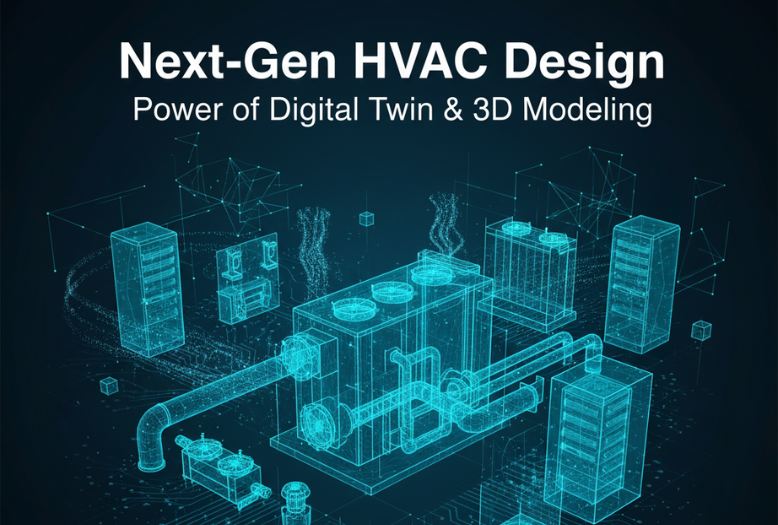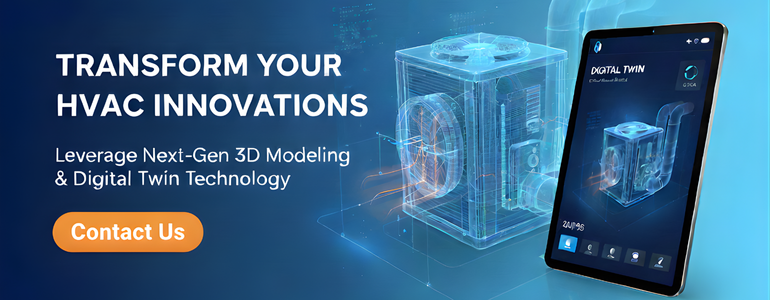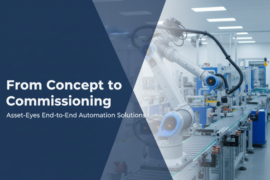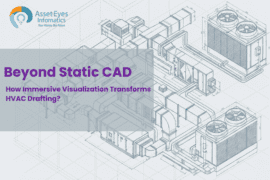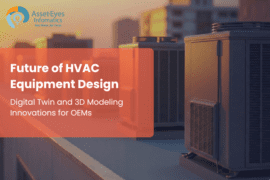Have you ever found yourself explaining a complex HVAC equipment design to your manufacturing team, only to discover they’ve interpreted your documentation differently than intended? Or perhaps you’ve watched as a meticulously designed system faces unexpected challenges during installation because what worked perfectly in theory didn’t translate to the real world? If you’ve experienced these situations, you’re definitely not alone. For HVAC original equipment manufacturers (OEMs), bridging the gap between design vision and manufacturing reality has long been a persistent challenge.
Today, that challenge is being transformed by two revolutionary technologies: digital twins and advanced 3D modeling. These innovations aren’t just changing how HVAC equipment is designed, they’re fundamentally reshaping the entire product development lifecycle from concept to installation and beyond. For forward-thinking manufacturers, these tools offer unprecedented opportunities to improve accuracy, reduce costs, and bring better products to market faster.
In this blog, we’ll explore how these emerging technologies are revolutionizing HVAC equipment design and drafting, what benefits they offer to OEMs, and how specialized drafting services can help you leverage these innovations for competitive advantage.
1. Digital Twin Technology: Your Equipment’s Virtual Counterpart
What Is a Digital Twin?
A digital twin goes well beyond being a simple 3D model of your HVAC equipment. It’s a dynamic, data-driven virtual representation that mirrors not just what your equipment looks like, but how it actually behaves in real-world conditions. Unlike static models, digital twins evolve over time, learning and updating as they collect data from their physical counterparts.
“Think of a digital twin as your equipment’s digital doppelgänger,” as one engineering expert puts it. “It’s not just what your equipment looks like, but how it performs under various conditions, how it ages, and how it might fail.”
Real-Time Performance Simulation
For HVAC OEMs, digital twin technology offers powerful simulation capabilities that transform the design process:
- Thermal behavior modeling: Digital twins can simulate heat transfer throughout a system under different conditions, allowing you to identify potential hotspots or inefficiencies before fabricating a single component.
- Energy consumption prediction: By running various operational scenarios, you can accurately predict how your equipment will perform in different environments and optimize designs for maximum efficiency.
- Failure analysis and prevention: Digital twins can predict potential component failures based on usage patterns, enabling preventative maintenance recommendations and design improvements that extend equipment life.
When one Florida-based OEM implemented digital twin technology for their commercial rooftop units, they discovered a potential refrigerant flow restriction issue that would have affected thousands of units. By identifying this problem during the design phase, they avoided a costly redesign that would have disrupted their entire production line.
The IoT Connection
The true power of digital twins emerges when combined with Internet of Things (IoT) sensors embedded in physical HVAC equipment. This integration creates a continuous improvement loop:
- Physical equipment generates operational data via sensors
- Data feeds back to the digital twin platform
- The digital twin continuously refines its behavior models using real-world performance data.
- Engineers analyze the updated models to identify optimization opportunities
- Design improvements are implemented in the next generation of equipment
This dynamic feedback loop is transforming how HVAC manufacturers approach product development, enabling continuous improvement based on actual performance data rather than theoretical models.
2. Advanced HVAC Design 3D Modeling: Beyond Basic CAD
Modern 3D CAD software has evolved far beyond basic shape creation. Today’s advanced modeling platforms support sophisticated capabilities that are particularly valuable for complex HVAC equipment design:
Parametric Modeling for Flexibility
Parametric modeling builds relationships between dimensions and features directly into the model itself. For HVAC equipment design, this provides exceptional adaptability.
“Parametric modeling allows us to make a change to one component and have that change automatically propagate throughout the entire assembly,” notes an industry CAD manager. “What used to take days of manual drafting revisions now happens in minutes.”
This capability is particularly valuable for OEMs that offer customized equipment configurations. With parametric models in SolidWorks design environments, manufacturers can quickly modify designs based on specific project requirements without starting from scratch each time.
Integrated Simulation Capabilities
Modern 3D modeling platforms now integrate computational fluid dynamics (CFD) capabilities directly into the design environment. This allows HVAC engineers to:
- Visualize airflow patterns through equipment
- Identify potential areas of turbulence or stagnation
- Optimize component placement for thermal performance
- Reduce pressure drops and increase energy efficiency
CFD analysis that once required specialized software and dedicated simulation experts can now be conducted within the same environment where the equipment is being designed. This democratization of simulation capabilities means that even smaller HVAC OEMs can leverage advanced analysis in their product development.
Generative Design: AI-Powered Innovation
Perhaps the most exciting frontier in 3D modeling for HVAC is generative design, an approach where artificial intelligence algorithms create optimized design options based on specified parameters and constraints.
Here’s how it works for HVAC equipment:
- Engineers define functional requirements and constraints (size limitations, airflow requirements, efficiency targets)
- The generative design software explores thousands of possible variations
- AI algorithms evaluate each variation against requirements
- The system presents multiple viable options, often with designs humans might never have conceived
3. Practical Applications Transforming HVAC Design Manufacturing
Streamlined Prototyping and Testing
The combination of digital twins and advanced 3D modeling has dramatically reduced the need for physical prototypes in HVAC equipment development:
“We’ve cut our prototyping cycles by 60% since implementing digital twin technology,” says one R&D Director at a major HVAC manufacturer. “We now build physical prototypes much later in the development process, after we’ve already resolved most design issues virtually.”
This approach offers several advantages:
- Cost reduction: Reducing the number of physical prototypes helps lower development expenses.
- Faster time-to-market: Virtual testing can be conducted in parallel rather than sequentially
- More thorough testing: Digital environments allow testing under extreme conditions that would be difficult or dangerous to replicate physically
- Broader optimization: Engineers can test many more design variations than would be feasible with physical prototypes
Enhanced Collaboration Across Teams
Modern 3D modeling platforms and digital twin environments are inherently collaborative, allowing multiple specialists to work on different aspects of the same equipment simultaneously:
- Mechanical engineers can focus on structural components
- Electrical engineers can design control systems and wiring
- Fluid dynamics specialists can optimize airflow pathways
- Manufacturing engineers can ensure producibility
Cloud-based platforms enable real-time collaboration across geographic locations, allowing global teams to contribute to the same project. This capability has become particularly valuable as remote work becomes more common in engineering disciplines.
At Asset-Eyes, we’ve built our service model specifically around this flexibility providing OEMs with on-demand access to specialized design talent that scales with your project needs. Our clients particularly value how quickly we can adapt to changing requirements without the delays typically associated with internal resource allocation.
Manufacturing Process Optimization
The benefits extend beyond design into manufacturing:
- Improved documentation: Digital models automatically generate precise manufacturing documentation, reducing errors in production
- Direct digital manufacturing: 3D models can feed directly into CNC machines and other automated manufacturing systems
- Assembly simulation: Engineers can virtually test assembly procedures to identify potential issues before production begins
- Quality control: Digital twins can serve as the “golden standard” against which manufactured components are compared
4. Implementation Challenges and Solutions
While the benefits are clear, implementing digital twin and advanced 3D modeling technologies presents challenges for many HVAC OEMs:
Technical Infrastructure Requirements
Digital twin platforms and advanced 3D modeling software demand significant computing resources. Cloud-based solutions have made these technologies more accessible to mid-sized manufacturers, but organizations must still ensure they have:
- Sufficient network bandwidth for data transfer
- Appropriate data storage solutions
- Compatible hardware for design engineers
- Robust cybersecurity measures to protect proprietary designs
For smaller OEMs, partnering with specialized CAD drafting services can provide access to these capabilities without the full infrastructure investment.
Skills Gap and Training Needs
The transition from traditional drafting to advanced 3D modeling and digital twin technologies requires new skill sets:
- Proficiency in parametric modeling software like SolidWorks
- Understanding of simulation principles and limitations
- Data analysis capabilities for interpreting digital twin outputs
- Systems thinking to conceptualize complex interactions
Many organizations are addressing this skills gap through a combination of hiring specialized talent, retraining existing staff, and partnering with external experts in SolidWorks drafting services. At Asset-Eyes, we support OEMs by translating their thermal and mechanical specifications into precise technical drawings that reflect optimal heat dissipation goals for various load conditions. Our CAD drafting services in SolidWorks ensure that complex heat exchange geometries are accurately represented for seamless integration into manufacturing workflows.
Data Integrity: The Foundation of Success
Perhaps the most crucial challenge is ensuring data integrity throughout the digital process. The accuracy and usefulness of both the 3D model and the subsequent digital twin are entirely dependent on the quality of the data input. This underscores the absolute necessity of accurate initial design work and the meticulous creation of all associated documentation.
Every piece of information, from the smallest fastener specification to the overall system layout captured in the HVAC CAD drafting, contributes to the reliability of the digital thread. Without this foundation of accurate data, even the most sophisticated digital twin will fail to deliver its promised benefits.
5. The Crucial Role of High-Quality Drafting
While 3D modeling and digital twins revolutionize the design and operational phases, they simultaneously elevate the importance of precise, manufacturing-ready documentation. A sophisticated 3D model is invaluable, but the production floor still requires clear, unambiguous instructions to build the equipment correctly.
Translating complex 3D SolidWorks design data into detailed 2D drafting drawings and comprehensive general assembly drawing sets is a critical step. These drawings must capture all necessary dimensions, tolerances, material specifications, and assembly sequences accurately. Without this meticulous documentation, the benefits gained in the digital design phase can be lost in manufacturing discrepancies and delays.
The precision required to build equipment that will accurately feed a digital twin demands a higher standard for every line, dimension, and note on the manufacturing drawings. This is where expert CAD drafting services become indispensable.
6. How Asset-Eyes Supports HVAC OEMs in Digital Transformation?
At Asset-Eyes, we understand the critical role that precise drafting plays in the digital transformation journey. Our expert CAD drafting services seamlessly connect advanced digital designs with practical manufacturing processes.
Our team of experts specializes in:
- Creating detailed SolidWorks designs and general assembly drawings that serve as the foundation for digital twin implementation
- Translating complex 3D models into clear, accurate 2D documentation for manufacturing
- Guaranteeing that all electrical control panel design documentation complies with industry standards and regulatory guidelines.
- Maintaining data integrity throughout the documentation process
By partnering with Asset-Eyes, HVAC OEMs can:
- Leverage advanced modeling expertise without maintaining a full in-house team
- Ensure consistent quality in documentation and models
- Scale drafting resources according to project demands
- Focus internal engineering resources on core innovation rather than documentation
Our approach bridges the gap between traditional drafting practices and cutting-edge digital twin implementations, allowing for a smoother transition to these powerful new technologies.
7. The Future Outlook – HVAC Design
As we look ahead, we are paying attention to these trends that will further transform HVAC equipment design and drafting:
AR/VR Design Reviews
Augmented and virtual reality technologies are increasingly being integrated with 3D models and digital twins, allowing engineers to conduct immersive design reviews in virtual environments, visualize full-scale equipment before manufacturing, and train service technicians on virtual equipment.
Machine Learning for Design Optimization
As digital twins collect more operational data, machine learning algorithms will increasingly identify patterns in equipment performance across installations, suggest design optimizations based on real-world usage, and predict maintenance needs with greater accuracy.
The convergence of digital twin technology and advanced 3D modeling represents a fundamental shift in how HVAC equipment is designed, manufactured, and maintained. For OEMs willing to embrace these technologies and the high quality drafting services that support them the benefits are substantial: faster development cycles, more efficient products, reduced warranty claims, and new opportunities for service-based business models.
The future of HVAC equipment design is digital, connected, and collaborative. Is your organization ready to take advantage of these transformative technologies?
Contact Us Now:
📞 +91 9840895134

